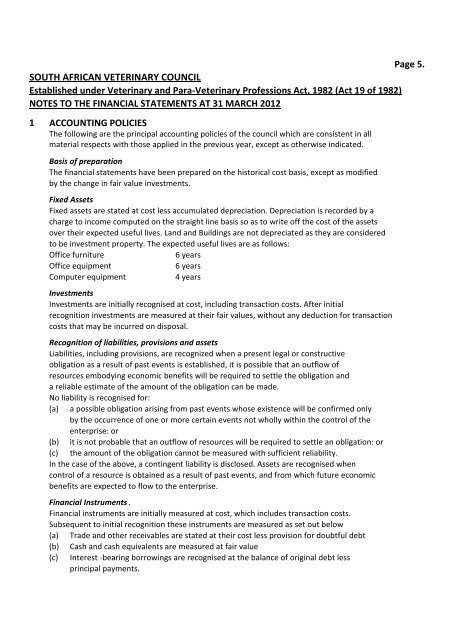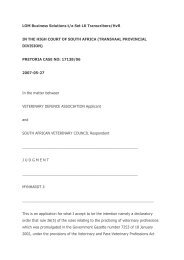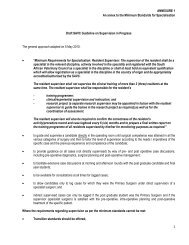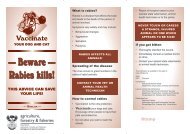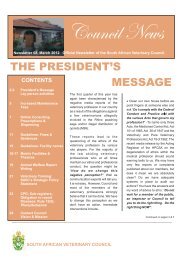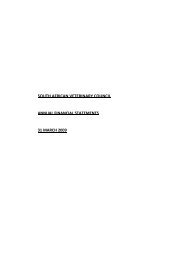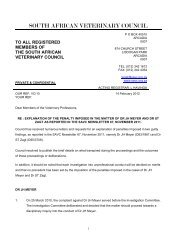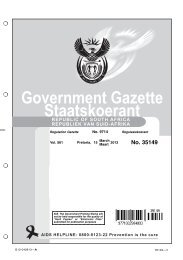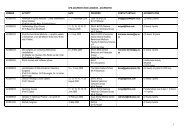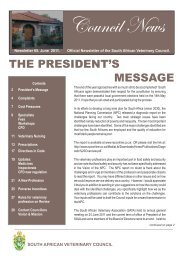Annual Report - the South African Veterinary Council
Annual Report - the South African Veterinary Council
Annual Report - the South African Veterinary Council
Create successful ePaper yourself
Turn your PDF publications into a flip-book with our unique Google optimized e-Paper software.
Page 5.<br />
SOUTH AFRICAN VETERINARY COUNCIL<br />
Established under <strong>Veterinary</strong> and Para-<strong>Veterinary</strong> Professions Act, 1982 (Act 19 of 1982)<br />
NOTES TO THE FINANCIAL STATEMENTS AT 31 MARCH 2012<br />
1 ACCOUNTING POLICIES<br />
The following are <strong>the</strong> principal accounting policies of <strong>the</strong> council which are consistent in all<br />
material respects with those applied in <strong>the</strong> previous year, except as o<strong>the</strong>rwise indicated.<br />
Basis of preparation<br />
The financial statements have been prepared on <strong>the</strong> historical cost basis, except as modified<br />
by <strong>the</strong> change in fair value investments.<br />
Fixed Assets<br />
Fixed assets are stated at cost less accumulated depreciation. Depreciation is recorded by a<br />
charge to income computed on <strong>the</strong> straight line basis so as to write off <strong>the</strong> cost of <strong>the</strong> assets<br />
over <strong>the</strong>ir expected useful lives. Land and Buildings are not depreciated as <strong>the</strong>y are considered<br />
to be investment property. The expected useful lives are as follows:<br />
Office furniture<br />
6 years<br />
Office equipment<br />
6 years<br />
Computer equipment<br />
4 years<br />
Investments<br />
Investments are initially recognised at cost, including transaction costs. After initial<br />
recognition investments are measured at <strong>the</strong>ir fair values, without any deduction for transaction<br />
costs that may be incurred on disposal.<br />
Recognition of liabilities, provisions and assets<br />
Liabilities, including provisions, are recognized when a present legal or constructive<br />
obligation as a result of past events is established, it is possible that an outflow of<br />
resources embodying economic benefits will be required to settle <strong>the</strong> obligation and<br />
a reliable estimate of <strong>the</strong> amount of <strong>the</strong> obligation can be made.<br />
No liability is recognised for:<br />
(a) a possible obligation arising from past events whose existence will be confirmed only<br />
by <strong>the</strong> occurrence of one or more certain events not wholly within <strong>the</strong> control of <strong>the</strong><br />
enterprise: or<br />
(b) it is not probable that an outflow of resources will be required to settle an obligation: or<br />
(c) <strong>the</strong> amount of <strong>the</strong> obligation cannot be measured with sufficient reliability.<br />
In <strong>the</strong> case of <strong>the</strong> above, a contingent liability is disclosed. Assets are recognised when<br />
control of a resource is obtained as a result of past events, and from which future economic<br />
benefits are expected to flow to <strong>the</strong> enterprise.<br />
Financial Instruments .<br />
Financial instruments are initially measured at cost, which includes transaction costs.<br />
Subsequent to initial recognition <strong>the</strong>se instruments are measured as set out below<br />
(a) Trade and o<strong>the</strong>r receivables are stated at <strong>the</strong>ir cost less provision for doubtful debt<br />
(b)<br />
(c)<br />
Cash and cash equivalents are measured at fair value<br />
Interest -bearing borrowings are recognised at <strong>the</strong> balance of original debt less<br />
principal payments.


